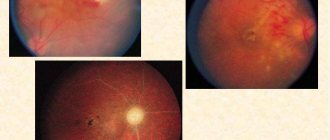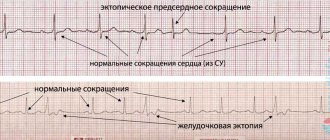Arterial hypertension during pregnancy: diagnosis, treatment, prognosis
R.I.STRYUK,
Doctor of Medical Sciences, Professor,
Y.V. BRYTKOVA
, Candidate of Medical Sciences, Moscow State Medical and Dental University named after. A.I. Evdokimov" of the Ministry of Health of the Russian Federation
The article presents the classification of arterial hypertension (AH) in pregnant women, provides an algorithm for diagnostic studies, discusses the issues of pharmacotherapy of hypertension during pregnancy, and emphasizes that the presence of hypertension during pregnancy is a risk factor for the development of cardiovascular pathology in women in subsequent periods of life.
Arterial hypertension (AH)
during pregnancy remains the leading cause of maternal, fetal and neonatal mortality in developing and industrialized countries. In different regions of Russia, its frequency ranges from 7 to 29%; in Western Europe, hypertension occurs in approximately 15% of pregnant women [1, 2]. Women with hypertension have a higher risk of severe complications - both from the mother and from the fetus. Thus, when analyzing 15,945 births, researchers significantly more often noted in women with hypertension (888 women, or 5.5%) premature births, abruption of a normally located placenta, cases of surgical delivery by cesarean section, and a low newborn Apgar score (1-1). 1st and 5th minutes <7 points), newborn weight ≤ 2,500 g, need for intensive care of newborns, immaturity and prematurity of the fetus, birth trauma, neonatal mortality [3]. Risk factors, in addition to hypertension, also include maternal age ≥ 30 years, low level of education, number of previous births ≥ 3, weight gain ≥ 16 kg during pregnancy, dyslipidemia, obesity, family history, antiphospholipid syndrome and impaired glucose tolerance [ 4].
It must be emphasized that the diagnostic criteria for hypertension in pregnant women are the same as for other categories of patients: an increase in systolic blood pressure ≥ 140 mm Hg. or diastolic blood pressure ≥ 90 mm Hg. [5, 6]. The presence of hypertension before pregnancy or the detection of elevated blood pressure in a woman during pregnancy requires a thorough examination of her to decide on the possibility of prolonging pregnancy, selecting adequate antihypertensive therapy and monitoring the condition of the fetus. In this case, it is necessary to take into account a number of physiological features of hemodynamics during gestation, caused by the influence of a complex of neurohumoral factors, an increase in body weight due to the placenta and the increasing weight of the fetus, increased metabolism, the development of physiological hypervolemia, and the formation of uteroplacental blood flow. During pregnancy, physiological myocardial hypertrophy develops - myocardial mass increases by 10–31% by the end of the gestational period and quickly returns to its original level after childbirth. The gestation period is accompanied by an increase in minute (by 15–50%) and stroke (by 13–29%) heart volume, blood flow velocity (by 50–83%), heart rate (by 15–20 beats/min), and a decrease in general peripheral resistance vessels (on average by 12–34%). During normal pregnancy, systolic blood pressure (BPs) changes slightly, diastolic blood pressure (BPd) at a period of 13–20 weeks decreases by 5–15 mm Hg. The lowest blood pressure is usually observed at the 28th week of pregnancy, then it increases, and in the third trimester blood pressure and blood pressure return to pre-pregnancy blood pressure values [7].
The gestational period is characterized by a physiological increase in the activity of the renin-angiotensin-aldosterone system, which contributes to an increase in plasma volume and total water volume in the pregnant woman’s body. An important factor in the adaptation of the cardiovascular system to pregnancy is systemic vasodilation, in the development of which increased secretion of nitric oxide and other vasodilating factors plays a role. A change in the reactivity of the vascular bed towards the predominance of vasodilation reactions is also associated with an increase in the level of estrogen and progesterone, which contribute to an increase in the sensitivity of adrenergic receptors to hormones of the sympathetic-adrenal system [8, 9]. In addition to a thorough history taking and assessment of physical data, pregnant women with hypertension must undergo ECG and EchoCG studies, blood and urine tests, biochemical blood tests to determine glucose levels, levels of liver enzymes, creatinine, and, if necessary, indicators of the hemostatic system. The protein content in daily urine should be determined (if it exceeds 2 g/day, careful monitoring is recommended; if proteinuria exceeds 3 g/day, the feasibility of delivery should be discussed). Uterine artery Doppler imaging in the second trimester reveals uteroplacental hypoperfusion, which is associated with a higher risk of preeclampsia and intrauterine growth restriction in both high- and low-risk women [208].
Arterial hypertension in pregnant women is not a homogeneous condition; it includes the following forms [5, 6]: - arterial hypertension existing before pregnancy (hypertension or symptomatic hypertension - chronic hypertension (CAH)); - gestational hypertension; - arterial hypertension existing before pregnancy and combined with gestational hypertension and proteinuria; - unclassified hypertension.
The criterion for diagnosing CAH is an increase in blood pressure ≥ 140/90 mmHg. before pregnancy or in the first 20 weeks of pregnancy. Arterial hypertension usually persists for more than 42 days after delivery and may be accompanied by proteinuria. In women with undiagnosed hypertension, blood pressure may be normal at the beginning of pregnancy due to its physiological decrease in the first trimester.
Gestational hypertension, with or without proteinuria, develops after 20 weeks of gestation and in most cases resolves within 42 days after birth. Gestational hypertension complicates pregnancy in 6-7% of cases; it leads to deterioration of organ perfusion.
Preeclampsia (in Russian literature - gestosis)
– this is gestational hypertension, which is accompanied by proteinuria (≥ 0.3 g/day in daily urine). Preeclampsia is considered a systemic disease that causes changes in the body of both mother and fetus. Overall, preeclampsia complicates pregnancy in 5–7% of cases, but its incidence increases to 25% in women with pre-pregnancy hypertension [10]. Preeclampsia is more common in first pregnancies, multiple pregnancies, hydatidiform moles, and diabetes mellitus. It is combined with placental insufficiency, which often leads to poor fetal growth and is one of the most common causes of prematurity. The share of preeclampsia in the structure of causes of birth of children with very low body weight (less than 1,500 g) is 25% [11]. Symptoms of severe preeclampsia include: - pain in the right hypochondrium or epigastric region due to liver edema + liver bleeding; - headache + blurred vision (cerebral edema); - blindness associated with damage to the occipital lobe; — strengthening of reflexes + clonus; - convulsions (cerebral edema); - HELLP syndrome: hemolysis, increased liver enzymes, decreased platelet count.
Edema today is no longer considered a diagnostic criterion for preeclampsia, because their frequency during normal pregnancy reaches 60%. Arterial hypertension existing before pregnancy, in combination with gestational hypertension and proteinuria, is characterized by a further increase in blood pressure and the appearance of proteinuria ≥ 3 g/day after 20 weeks of gestation.
Hypertension is classified as unclassifiable if blood pressure is first measured after 20 weeks of pregnancy and hypertension is detected (with or without systemic manifestations). In such cases, it is necessary to continue monitoring blood pressure for 42 days after birth and beyond.
The tactics for managing pregnant women with hypertension consists of measures aimed at ensuring a protective regime, which includes the woman’s employment with the exception of shift work, physical and psycho-emotional overload, sufficient sleep, and rest during the daytime. Nutrition should be complete in composition and not excessive in calorie content, especially in obese women. About half of the food composition should be animal proteins. It is recommended to consume foods containing predominantly complex carbohydrates - wholemeal bread, cereals, vegetables, fruits, berries, and easily digestible carbohydrates (sugar, confectionery) should be limited. Food must contain a sufficient amount of vitamins, because... the need for them during pregnancy increases significantly. It is advisable to have a varied menu, including low-fat dairy products, unsalted cheeses, meat, fish, liver, kidneys, eggs, legumes, etc. The diet should not include fatty meats and fish, smoked meats, pickles, chocolate, strong tea and coffee. . Weight loss for obese pregnant women is not recommended, because... it can lead to a decrease in the newborn's body weight and a subsequent slowdown in his growth. However, obesity can cause adverse outcomes for both the woman and the fetus, so the suggested ranges for weight gain during pregnancy should be adhered to: for women with a normal body mass index (< 25 kg/m2), the recommended weight gain is 11.2 –15.9 kg, in overweight women (25.0–29.9 kg/m2) – 6.8–11.2 kg, in obese women (≥ 30 kg/m2) – < 6.8 kg [12].
The issues of drug therapy for hypertension during pregnancy are quite complex; the range of antihypertensive drugs is narrow, because any impact, incl. medication may have a negative effect on the fetus, and with a beneficial effect on the fetus, the drug may be suboptimal for the mother. The embryotoxic and teratogenic effects of drugs appear at different stages of pregnancy. Thus, up to 20 days after conception, the “all or nothing” principle applies, based on the fact that at this stage the pluripotent cells of the embryo capable of regeneration have not yet been differentiated. At 3–8 weeks of pregnancy, during the period of active organogenesis, the most sensitive period in relation to the negative effects of drugs, a teratogenic effect appears. After the 8th week before birth, the embryotoxic effect of the drugs may be detected. During this period of growth, structural defects, as a rule, do not occur, but disruption of postnatal functions and various behavioral abnormalities are possible. However, a recent analysis of the effectiveness of antihypertensive therapy in pregnant women with mild and moderate hypertension (46 studies (4,282 women) and 28 studies (3,200 women), respectively) showed that the prescription of one or more antihypertensive drugs led to a 2-fold reduction in the risk of developing severe hypertension (19 studies, 2409 women, relative risk (RR) 0.50, 95% confidence interval (CI) 0.41 to 0.61; risk difference (RR) -0.10 (-0 .12 to -0.07)) [13].
According to the recommendations of the VNOK and the European Association of Cardiology for the treatment of pregnant women with cardiovascular diseases, in patients with a blood pressure level of 140/90 mm Hg. antihypertensive therapy is not carried out, but is prescribed in such cases as: - gestational hypertension ± proteinuria; — CAH combined with gestational hypertension; — Hypertension, accompanied by subclinical target organ damage or clinical symptoms.
Antihypertensive therapy is recommended to begin if blood pressure exceeds 150/95 mmHg.
The general principles of drug treatment of hypertension are: - maximum effectiveness for the mother and safety for the fetus; — starting treatment with minimal doses of one drug; - switching to drugs of another class if the treatment effect is insufficient (after increasing the dose of the first drug) or is poorly tolerated; - if a woman is taking an antihypertensive drug at the stage of pregnancy planning, adjustment of drug therapy (cancellation of angiotensin-converting enzyme inhibitors, angiotensin II receptor blockers, direct renin inhibitors) and dose of the drug (achieving a target blood pressure level < 140/90 mm Hg); - use of long-acting drugs to achieve a 24-hour effect with a single dose.
The use of such drugs provides a milder and longer-lasting antihypertensive effect, more intense protection of target organs, as well as high patient adherence to treatment. It is very important not to sharply reduce blood pressure, because this may impair uteroplacental blood flow. The blood vessels of the placenta function in a maximally dilated state and are not capable of autoregulation, so a drop in blood pressure in the mother’s bloodstream can worsen the condition of the fetus.
In accordance with the classification of foods and drugs adopted by the Food and Drug Administration (FDA) [14], there are 5 categories of drugs according to the level of safety for the fetus:
A. Controlled studies have shown no risk to the fetus. B. Lack of evidence of risk to the fetus: a risk to the fetus has been found in animals, but not in humans, or there is no risk in the experiment, but there are insufficient studies in humans. C. Risk to the fetus cannot be excluded - side effects have been identified in animals, but there are insufficient studies in humans. The expected therapeutic effect of the drug may justify its use, despite the potential risk to the fetus. D. Conclusive evidence of risk—in humans, there is a proven risk to the fetus, but the expected benefit to the expectant mother may outweigh the potential risk to the fetus. X. Use during pregnancy cannot be justified: the negative effects on the fetus outweigh the potential benefits of this drug for the expectant mother.
In accordance with the recommendations of the All-Russian Scientific Society of Cardiology (2010), ESH/ESC experts currently use 4 groups of antihypertensive drugs that meet the criteria for pharmacotherapy during pregnancy for the treatment of hypertension during pregnancy [5, 6]: - centrally acting drugs (methyldopa) ; - calcium antagonists of the dihydropyridine series (long-acting nifedipine); - cardioselective β-blockers (metoprolol, bisoprolol); - α-β-adrenergic blockers (laβlol).
Combination therapy is carried out in case of ineffectiveness of monotherapy at the maximum dose. A rational combination is long-acting nifedipine + β-blocker; if this combination is ineffective, it is possible to add chlorothiazide (hypothiazide) in small doses (12.5–25.0 mg/day).
The main medications recommended for use during pregnancy for the treatment of hypertension are presented in the table.
If we talk in more detail about each group of antihypertensive drugs used in pregnant women, then we should first of all talk about methyldopa, a centrally acting antiadrenergic drug classified as category B according to the FDA classification. A single study conducted about 30 years ago demonstrated the safety of methyldopa based on long-term follow-up of newborns (7.5 years), and since then it has been considered a first-line drug in patients with hypertension [15, 16]. However, it must be remembered that the side effects of methyldopa are drowsiness, the development of depression, fluid retention and edema, orthostatic hypotension; in the 16th–20th week of pregnancy, the use of the drug is not recommended due to its effect on the content of dopamine in the fetal nervous system.
In 2007, data were published evaluating the effectiveness of antihypertensive therapy in women with mild to moderate hypertension during pregnancy: 19 studies (1282 women) compared β-blockers with methyldopa in reducing the risk of developing severe hypertension (10 studies, 539 women , RR 0.75 (95% CI 0.59 to 0.94); RD -0.08 (-0.14 to 0.02); NNT 12 (6,275)). β-blockers were found to be better than methyldopa in reducing the risk of severe hypertension (10 studies, 539 women, RR 0.75 (95% CI 0.59 to 0.94); RD -0.08 (- 0.14 to 0.02); NNT 12 (6,275)). Along with this, there was no clear difference between any of the alternative drugs with respect to the risk of developing proteinuria/preeclampsia in patients with CAH [17].
The second group of drugs used for hypertension in pregnant women are cardioselective β-blockers. They belong to category C (FDA), and are recommended for use from the second trimester of pregnancy. The mechanism of action of drugs in this group is due to the fact that they competitively and selectively inhibit the binding of catecholamines to β-adrenergic receptors. Drugs in this group are divided into cardioselective, predominantly blocking β1-adrenergic receptors, and non-selective, blocking β1- and β2-adrenergic receptors. The principal mechanism of their inhibitory effect on adrenoreactive structures is to weaken or eliminate the effects associated with excitation of β1-adrenergic receptors by catecholamines, which cause increased heart rate, increased automaticity of the atrioventricular node and myocardial excitability, increased impulse conduction speed, increased myocardial contractility, decreased refractory period , activation of lipolysis. Excitation of β2-adrenergic receptors by catecholamines leads to dilation of arterioles, decreased tone of smooth muscles of the bronchi, bladder, uterine tone during pregnancy, tremor of skeletal muscles, inhibition of the release of histamine, leukotrienes in mast cells during allergic reactions of type I, hypokalemia, increased hepatic glycogenolysis. During pregnancy, β-blockers can cause intrauterine growth retardation due to a decrease in uteroplacental and fetoplacental blood flow and induction of premature labor. This is especially true for atenolol, which belongs to FDA category D and is not recommended for use during pregnancy. When using drugs in this group, the fetus may experience various side effects: bradycardia, hypoglycemia, apnea, metabolic disorders. However, the frequency of these adverse events is quite low, and if it is necessary to prescribe β-blockers, the balance of benefit and risk is considered.
In 2003, Magee LA et al. based on an analysis of systematic reviews of the Cochrane Library and data from various registries, they summarized the experience of using β-blockers for the treatment of mild and moderate hypertension in pregnant women [18]. The authors analyzed 29 clinical studies (approximately 2,500 women) that compared the effectiveness and safety of β-blockers with placebo, no therapy, or other antihypertensive drugs. Oral β-blockers were shown to reduce the risk of developing severe hypertension (RR 0.37, CI 95% (0.26–0.53); 11 CIs, N = 1,128 women) and the need for additional antihypertensive therapy (RR 0.44, CI 95% (0.31–0.62); 7 CI, N = 856 women). The authors do not draw conclusions on the effect of β-blockers on mortality rates and premature birth of the fetus due to the lack of sufficient information in the analyzed CTs. However, β-blocker use was associated with an increase in the number of small gestational age neonates (RR 1.36, CI 95% (1.02–1.82); 12 CIs, N = 1,346 women), with an increase in neonatal bradycardia and reduction in neonatal respiratory distress, but these endpoints were analyzed in a small number of CTs. The authors’ conclusion that blood pressure control in a mother with hypertension using β-blockers can be justified only if there is significant benefit for the mother and/or child is absolutely justified, but the analyzed clinical studies did not answer the question.
Von Dadelszen P., Ornstein MP (2000) analyzed data from 45 randomized controlled trials (RCTs) and found an inverse relationship between the reduction in mean blood pressure during treatment with beta-blockers and the incidence of births of newborns whose size is not appropriate for their gestational age. Decrease in average blood pressure for every 10 mm Hg. was accompanied by a decrease in birth weight by 145 g (with a 95% confidence interval from 5 to 285 g). However, no relationship was found between the duration of antihypertensive therapy and mean birth weight [19]. Calcium antagonists (CA), the first representative of which is verapamil, synthesized in 1962 in Germany, are the drugs of choice for the treatment of hypertension; according to the FDA classification, drugs in this group belong to category C. Calcium antagonists are heterogeneous in chemical structure, electrophysiological properties, pharmacological effects and clinical use. To treat hypertension during pregnancy, dihydropyridine calcium antagonists are used, the main mechanism of action of which is associated with peripheral vasodilation due to the blockade of slow voltage-dependent L-type calcium channels and a decrease in the intracellular concentration of Ca2+, as well as stimulation of endothelial synthesis of NO and bradykinin [20, 21]. The body's compensatory response to systemic vasodilation is the activation of the sympathetic-adrenal system. However, a number of studies have shown that not all drugs in this group have a similar effect. As a rule, short-acting dosage forms of nifedipine lead to sympathetic activation with the development of reflex tachycardia, while no increase in heart rate was recorded with the use of a long-acting form of nifedipine [21, 22]. The results of a multicenter randomized study indicate that routine administration of long-acting nifedipine for mild to moderate hypertension in the second trimester of pregnancy does not have a positive effect on pregnancy outcomes, but is not associated with an increased risk of negative effects on the fetus. Nifedipine did not lead to an increase in the incidence of congenital anomalies in 57 children exposed to it in the first trimester of pregnancy [23].
Along with this, it is necessary to emphasize that to relieve a hypertensive crisis in pregnant women, it is advisable to use short-acting nifedipine, excluding its sublingual administration, because a rapid decrease in blood pressure can provoke a deterioration in cerebral hemodynamics in the mother, a sharp decrease in uteroplacental blood flow and lead to fetal distress. In addition, you should pay attention to the categorical contraindication of the simultaneous administration of magnesium sulfate and other magnesium preparations with AK, because this can lead to the development of irreversible hypotension and other severe maternal and fetal complications.
When considering the management of patients with hypertension after childbirth, it should be noted that blood pressure usually increases in the first 5 days after childbirth. In women with hypertension during pregnancy, blood pressure may be normal after delivery, but then rise again during the 1st week. If hypertension occurred during the first pregnancy, the risk of its development in subsequent pregnancies increases [24]. There are observations that show that women with gestational hypertension or preeclampsia have an increased risk of developing hypertension, stroke and coronary artery disease in older age [25–27]. The highest risk is observed in women with early-onset preeclampsia (delivery before 32 weeks of gestation), stillbirth, or intrauterine growth restriction [28]. Due to the fact that hypertension during pregnancy is considered an important risk factor for the development of cardiovascular complications in women in subsequent periods of life, after childbirth, women with hypertension and risk factors are recommended to adjust their lifestyle, regularly monitor blood pressure and metabolic parameters in order to prevent complications during pregnancy. subsequent pregnancies and reduce the risk of cardiovascular outcomes in the future.
Literature
1. Kulakov V.I. Reproductive health of the Russian population. Obstetrics and Gynecology 1998; 5:3–6. 2. James PR, Nelson-Piercy C. Management of hypertension before, during, and after pregnancy. Heart 2004;90:1499–1504. 3. Madi JM, Araújo BF, Zatti H, Rombaldi RL et al. Hypertension Pregnancy. 2010 Dec 21. 4. Madi JM, Araújo BF, Zatti H, Rombaldi RL et al., BJOG. 2010 Aug; 117(9):1080-6. Epub 2010 May 19. 5. Diagnosis and treatment of cardiovascular diseases during pregnancy. Recommendations of the All-Russian Scientific Society of Cardiologists. M., 2010. 6. Guidelines on the management of cardiovascular diseases during pregnancy. European Heart Journaldoi:10.1093/eurheartj/ehr218. 7. Stryuk R.I. Cardiovascular diseases and pregnancy. M.: GEOTAR-Media, 2010. 278 p. 8. Sundlof G., Wallin BG, Stromgren E., Nerhed S. Acute effects of metoprolol on muscle sympathetic activity in hypertensive humans. Hypertension 1983; 5: 749–56. 9. Wallin BG, Sundlof G., Stromgren E., Aberg H. Sympathetic outflow to muscles during treatment of hypertension with metoprolol. Hypertension 1984; 6: 557–62]. 10. Steegers EA, von Dadelszen P, Duvekot JJ, Pijnenborg R. Pre-eclampsia. Lancet 2010;376:631–644. 11. Hiett AK, Brown HL, Britton KA Outcome of infants delivered between 24 and 28 weeks' gestation in women with severe pre-eclampsia. J Matern Fetal Med2001;10:301–304. 12. Leddy MA, Power ML, Schulkin J. The impact of maternal obesity on maternaland fetal health. Rev Obstet Gynecol 2008;1:170–178. 13. Abalos E, Duley L, Steyn DW, Henderson-Smart DJ Cochrane Database Syst Rev. 2007 Jan 24;(1):CD002252. 14. Drugs in Pregnancy and Lactation: A Reference Guide to Fetal and Neonatal Risk by Gerald G. Briggs, Roger K. Freeman, and Summer J. Yaffe. Phyladelphia, LippincottWilliamsandWilkins, 2005: 1858 p. 15. Redman CW. Fetal outcome in trial of antihypertensive treatment in pregnancy. Lancet 1976;2:753–756. 16. Cockburn J, Moar VA, Ounsted M, Redman CW. Final report of study on hypertension during pregnancy: the effects of specific treatment on the growth and development of the children. Lancet 1982;1:647–649. 17. Abalos E, Duley L, Steyn DW, Henderson-Smart DJ. Cochrane Database Syst Rev. 2007 Jan 24;(1):CD002252 18. Magee LA, Duley L. 22. Wenzel RR, Allegranza G, Binggeli C, Shaw S, Weidmann P, Luscher TF, Noll G. Differential activation of the cardiac and peripheral sympathetic nervous system by nifedipine: role of pharmacokinetics. J Am CollCardiol 1997; 29: 1607-14. 23. Magee LA, Schick B, Donnenfeld AE et al. The safety of calcium channel blockers in human pregnancy: a prospective, multicenter cohort study. Am.J.Obst. Gynecol 1996; 174: 823-28. 24. Hargood JL, Brown MA. Pregnancy-induced hypertension: recurrence rate in second pregnancies. Med J Aust 1991;154:376–377. 25. Wilson BJ, Watson MS, Prescott GJ, Sunderland S, Campbell DM, Hannaford P, Smith WC. Hypertensive diseases of pregnancy and risk of hypertension and stroke in later life: results from cohort study. BMJ 2003;326:845. 26. Ray JG, Vermeulen MJ, Schull MJ, Redelmeier DA. Cardiovascular health after maternal placental syndromes (CHAMPS): population-based retrospective cohort study. Lancet 2005;366:1797–1803. 27. McDonald SD, Malinowski A, Zhou Q, Yusuf S, Devereaux PJ. Cardiovascular sequelae of preeclampsia/eclampsia: a systematic review and meta-analyses. Am Heart J 2008;156:918–930 28. Mosca L, Benjamin EJ, Berra K, Bezanson JL, Dolor RJ, Lloyd-Jones DM, Newby LK, Pina IL, Roger VL, Shaw LJ, Zhao D., Beckie TM, Bushnell C., D'Armiento J., Kris-Etherton PM, Fang J., Ganiats TG, Gomes AS, Gracia CR, Haan CK, Jackson EA, Judelson DR, Kelepouris E., Lavie CJ, Moore A., Nussmeier NA, Ofili E., Oparil S., Ouyang P., Pinn VW, Sherif K., Smith SC Jr., Sopko G., Chandra-Strobos N., Urbina E.M., Vaccarino V., Wenger N.K. Effectiveness-based guidelines for the prevention of cardiovascular disease in women 2011 update: a Guideline from the American Heart Association. Circulation 2011; 123:1243–1262.
Appendix table
Causes of high blood pressure in pregnant women
Arterial hypertension in expectant mothers usually develops after the twentieth week as part of the so-called gestosis, a complication of the second half of pregnancy.
If an increase in pressure is detected before the midterm, this indicates that the pregnant woman had hypertension even before conception, even if the woman herself was not aware of its existence. How is this possible? Quite simple actually.
It must be said that hypertension among young women is not at all uncommon: even among 18-29 year olds its prevalence reaches 23%, and in older age the percentage of hypertensive patients is even higher. But due to the fact that in the initial stages of hypertension many do not feel unwell, they do not go to the doctor, their blood pressure is not measured, and the disease remains unrecognized. And with the onset of pregnancy, attention to the health of the expectant mother becomes more intense, so high blood pressure is quickly detected.
In addition to gestosis, there is another serious cause of arterial hypertension in pregnant women - obstructive sleep apnea syndrome. It affects about 5-7% of the population. During pregnancy, it can progress, leading to very serious consequences.
If your family tells you that you snore, be sure to ask them to watch you sleep. If it turns out that during sleep your snoring is interrupted by pauses in breathing lasting 10 seconds or more, this is a good reason to visit a sleep specialist. The fact is that respiratory arrests during sleep with apnea syndrome lead to acute oxygen starvation in the child. In response to stress, the expectant mother's body responds with the release of adrenaline, norepinephrine and other anxiety hormones, which leads to vasoconstriction and increased blood pressure.
Other causes of hypertension in pregnant women are also possible, usually they are renal and endocrine disorders that appeared or worsened while expecting a child.
Symptoms of arterial hypertension
The most common symptoms of high blood pressure are headache, dizziness, fatigue, and nausea. Sleep may also be disturbed, chest pain, palpitations, and shortness of breath often appear.
If you feel unwell, especially if you have previously had arterial hypertension, it is important to measure the pressure in both arms. If the numbers turn out to be different, you need to choose a larger value - this will be the real indicator. With figures of 140/90 mmHg. or higher, you must consult a doctor.











